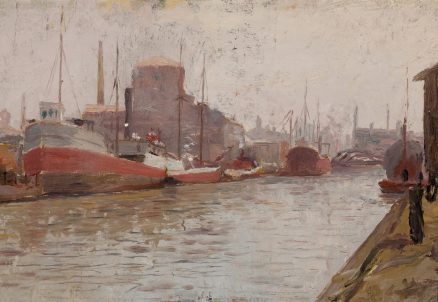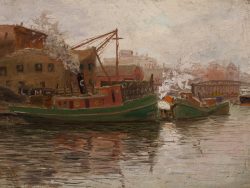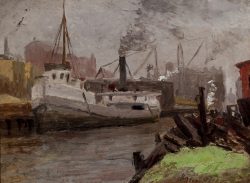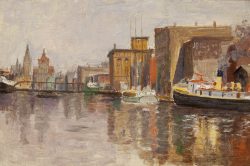Untitled (Chicago River No. 1)
, dated 1915 (verso)Oil on panel, 10 by 14 inches
- Zoom in on Artwork
- Print Page
- Email Page to Friend
This painting is part of a group discussed in the following essay.
All four Chicago River views by James Bolivar Needham are studies of boats and buildings seen at a distance across the water’s slick surface under a mottled gray sky. Painted with rapid, obvious brushstrokes, Needham’s views appear to be unedited, quickly captured records of transitory scenes as noted by an objective observer. Yet the artist selected his viewpoints carefully to achieve a balance of vertical and horizontal forms and contrasts of color. The diffused light and somewhat smoky atmosphere, typical of the river in its industrial heyday at the turn of the twentieth century, lend subtle pastel tints to far-off structures and their shimmering reflections. In Tugboats and Steamer in Harbor, the steam issuing in plumes from the boats’ stacks unites the solid forms of the vessels with the hazy atmosphere overhead. Chicago River No. 1 and No. 2 both feature a horizon line exactly balanced between the top and bottom edges of the composition, the lower portion of which mirrors the pale neutral tones of the sky, setting off the diagonally receding, more densely colored band of boats, buildings, and their reflections.
Having worked as a deckhand on the Great Lakes as a young man, Needham was intimately familiar with shipping on the Chicago River, which he painted almost exclusively for several decades. As an African American and an outsider in Chicago’s art world, Needham had few formal opportunities to study art, particularly the depiction of the figure; the river, however, was always available, offering along its length a constantly changing spectacle and spots where he could paint undisturbed. Needham’s paintings often depict specific locales and named vessels. Yet the artist was less interested in physical details and identity than in creating compositions from the elements before him, particularly the subtle color effects resulting from the river’s shifting light and atmosphere. Compared with Goose Island, a Chicago River painting by the artist’s reputed teacher Albert Fleury, Needham’s works reflect greater concern for capturing transient light effects than for surface “finish.” This quality and his works’ apparent on-site execution suggest the artist’s awareness of impressionism, a radical approach to painting that was sweeping Chicago’s art scene in the early 1890s, just as he began painting the river.
Needham’s sensitivity to the “poetic” possibilities of the river, which was notorious in his day for its filth and noxious odors, made him an artistic pioneer in the mid-1890s. Within a few years a host of Chicago landscape painters, notably Fleury and William Clusmann, were discovering the river for themselves. By then Needham was painting in obscurity and the river itself faced industrial and commercial obsolescence thanks in part to implementation of portions of Daniel Burnham’s Plan of Chicago of 1909. As if acknowledging that reality, Needham’s images banish the frenzied activity that once characterized the city’s waterways, confining movement to the flickering surface of the water and wraiths of smoke.
These four paintings are typical of Needham’s works in their small scale and their medium: oil on panel (in the case of Chicago River No. 1) or oil on canvas wrapped around panel. Often the panels on which Needham painted appear to have been cut down from packing cases of the sort commonly carried on the very boats he pictured. Steamer in Harbor is cradled at the back, possibly to prevent warping as well as to provide a handle, allowing the artist to hold the panel with its edges free as he painted. Chicago River No. 1, Tugboats, and Steamer in Harbor feature Needham’s hallmark treatment of the backs of his supports: on a coat of matte black paint (possibly boat paint), he inscribed in red such information as the painting’s size and exact date of execution, enclosed in a red diamond-shaped outline. Steamer in Harbor and Chicago River No. 2 are among the very few known paintings by Needham that bear his signature on the front.
Wendy Greenhouse, PhD
Donated by M. Christine Schwartz to the Art Institute of Chicago, Chicago, Illinois, in 2023



